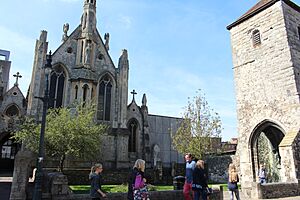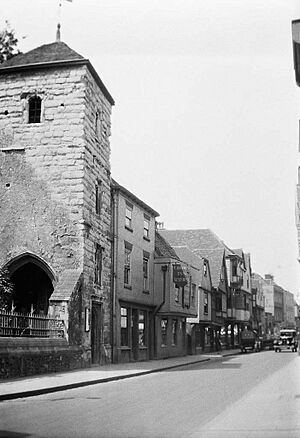St Thomas of Canterbury Church, Canterbury facts for kids
Quick facts for kids St Thomas' Church |
|
|---|---|
| St Thomas of Canterbury Church | |

North side of church
|
|
| Lua error in Module:Location_map at line 420: attempt to index field 'wikibase' (a nil value). | |
| OS grid reference | TR 15125 57759 |
| Location | Canterbury, Kent |
| Country | England |
| Denomination | Roman Catholic |
| Website | StThomasofCanterbury.com |
| History | |
| Status | Parish church |
| Founded | 1859 |
| Dedication | Thomas Becket |
| Relics held | Thomas Becket Óscar Romero |
| Architecture | |
| Functional status | Active |
| Architect(s) | John Green Hall |
| Style | Gothic Revival |
| Years built | 1874 to 1875 |
| Administration | |
| Deanery | Canterbury |
| Diocese | Southwark |
| Province | Southwark |
St Thomas of Canterbury Church is a Roman Catholic church in Canterbury, England. It's a special place of worship for the local community. The church was built a long time ago, between 1874 and 1875. It has a beautiful style called Gothic Revival.
You can find it in the heart of Canterbury, right across from the famous Canterbury Cathedral. It's the only Roman Catholic church in the city. The church was built where an older medieval church once stood. That old church was taken down in 1870. However, its ancient tower, called St Mary Magdalen’s Tower, was kept. Inside the church, you can find special items called relics of Thomas Becket.
Contents
History of the Church
How the Catholic Community Survived
After the English Reformation, it was hard to be Catholic in England. But the Catholic community in Canterbury managed to continue. This was thanks to a family called the Hales baronets.
Sir Thomas Hales, 2nd Baronet, helped Catholics after the Glorious Revolution in 1688. They held their church services, called Masses, at a chapel on his family's estate, Hales Place. Masses were held there until 1923. The chapel was later sold in 1928.
Starting a New Mission
In 1859, a new Catholic mission began in Canterbury. This happened when a woman named Mary Ann Wood gave her house at 59 Burgate Street for a Catholic priest to use. This house is now the presbytery, where the priests live.
More land around the house was bought later. This land was used to build a new church and a school. Part of this land included an old medieval chapel. This chapel was dedicated to St Mary Magdalene. In 1871, the chapel was taken down. But its historic tower was saved and still stands today.
Building the Church
Building work on the new church started in 1874. It was designed by a local architect named John Green Hall. The church was built in the Gothic architecture style. Another architect, E. W. Pugin, who worked at Hales Place, influenced the design.
The main altar and the Lady Chapel altar were designed by A. E. Purdie. The church officially opened on April 13, 1875. A very important church leader, Cardinal Henry Manning, who was the Archbishop of Westminster, gave a speech at the opening Mass.
Changes Over Time
The church has been changed and updated several times. In 1962 and 1963, big changes were made inside. A beautiful stained-glass window was added above the altar. It has a double rose design under a Gothic arch.
More major updates happened in the 1980s. A new octagonal altar, made of limestone and marble, was put in. The original high altar is still there too. A special font for baptisms, made in 1865, was also added.
Next to the main area is the Lady Chapel. It has a sculpture called a pieta. There are also statues of St. Constance and St George. The altar in this chapel was given to the church in 1905.
The Martyrs’ Chapel holds a special shrine. This shrine contains relics of St Thomas of Canterbury. The church's website says these relics are very old and real.
In 1963, an extension was added to the church. This part includes the Canterbury Saints Chapel. It has a large painting, or mural, called "The Canterbury Saints." This mural was created by Helen Grunwald.
The church also has a large organ. It is located in the organ loft at the west end. The organ was rebuilt in 1990.
Later Developments
In June 1942, during World War II, buildings around the church were damaged. This was during a bombing campaign known as The Blitz. In 1953, some special relics and Stations of the Cross were given to the church. These items had previously been at Westminster Cathedral. They were donated by Cardinal Bernard Griffin.
In the early 1960s, more extensions and changes were made. The north side of the church was extended with a modern, two-story building. A Martyrs Chapel was built on the south side. This chapel holds the relics of St Thomas of Canterbury. In 1989, the sanctuary area was updated again. Richard Fulbrook was the architect for this work. In 1997, a mosaic was placed in the north aisle. It shows St Augustine of Canterbury.
Special Relics
In the Martyrs Chapel, there is a reliquary above the altar. This is a special container. It holds a piece of clothing that belonged to Thomas Becket. It also has a small piece of bone from his body. These items were given to the church in the late 1800s by Mary Hales. The relics came from a town in Italy called Gubbio. They had been kept there since the 1220s.
In 1953, a man named Fr Thomas Becquet gave another relic to the church. He was a descendant of Thomas Becket's family. He gave a piece of Becket’s finger. On either side of the reliquary are statues of St John Fisher and St Thomas More. The chapel also has a stained glass window. It shows the death of St Thomas Becket, St Gregory the Great, and St Augustine of Canterbury.
There is another reliquary built into the wall. It holds parts of the special clothes worn by Óscar Romero. He was an Archbishop from El Salvador. These were given to the church in 1997. On the west wall of the Martyrs' Chapel, there is a statue of St John Stone.
Church Services
Masses are held at the church every weekday at Noon. On Saturdays, Masses are at Noon and 6pm. On Sundays, you can attend Mass at 8am, 9:30am, 11am, and 6pm.
See also
- Roman Catholic Archdiocese of Southwark



